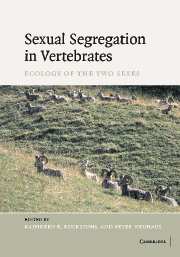Book contents
- Frontmatter
- Contents
- List of contributors
- Preface
- Part I Overview
- Part II Concepts and methodology
- Part III Foraging ecology
- Part IV Predator avoidance and reproductive strategies
- Part V Sex-related activities and social factors
- Part VI Sexual differences in ecology: comparisons within different taxa
- Part VII Implications for conservation
- 18 Sexual segregation in birds: patterns, processes and implications for conservation
- 19 Sexual segregation: a necessary consideration in wildlife conservation
- Part VIII Outlook
- References
- Index
18 - Sexual segregation in birds: patterns, processes and implications for conservation
Published online by Cambridge University Press: 04 September 2009
- Frontmatter
- Contents
- List of contributors
- Preface
- Part I Overview
- Part II Concepts and methodology
- Part III Foraging ecology
- Part IV Predator avoidance and reproductive strategies
- Part V Sex-related activities and social factors
- Part VI Sexual differences in ecology: comparisons within different taxa
- Part VII Implications for conservation
- 18 Sexual segregation in birds: patterns, processes and implications for conservation
- 19 Sexual segregation: a necessary consideration in wildlife conservation
- Part VIII Outlook
- References
- Index
Summary
OVERVIEW
It has been suggested recently that sexual segregation of male and female birds outside the breeding season, or away from their nest-sites, could be a general ecological trait of many migratory species (e.g. Lopez Ornat & Greenberg, 1990; Cristol et al., 1999), and one that may have important implications for population dynamics and conservation (Weimerskirch et al., 1997a; Croxall et al., 1998; Marra et al., 1998; Marra & Holmes, 2001). Segregation by sex can occur at varying spatial scales, ranging from broad geographical differences in distribution, to local differences in habitat or even microhabitat use. Segregation is relatively independent of mating systems or sex role specialization during reproduction. In many species of crane (Gruidae), for example, adult males and females, once paired, generally stay within each other's sight throughout the annual cycle, and even migrate together to reach their winter quarters (Archibald & Meine, 1996). In the great albatrosses, Diomedea spp., on the other hand, not only do members of a pair meet only briefly at the nest in between their long foraging trips (a direct consequence of their lifestyle), but they also largely forage in different geographical areas throughout both the breeding and non-breeding seasons (Weimerskirch et al., 1993; Prince et al., 1998, Weimerskirch & Wilson, 2000; see also Chapter 6). That both cranes and albatrosses are strictly monogamous, highly faithful to their mates during their long lives, display little differentiation in reproductive sex-roles and are highly migratory, does not prevent them from having such a contrasting pattern of sexual segregation in geographic and habitat distribution.
- Type
- Chapter
- Information
- Sexual Segregation in Vertebrates , pp. 351 - 378Publisher: Cambridge University PressPrint publication year: 2006
- 35
- Cited by



